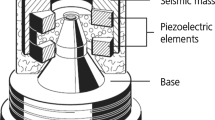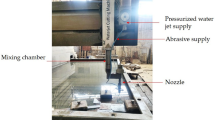Abstract
This paper presents a novel actuator design for vibration-induced micromachining. The bi-directional ultrasonic elliptical vibration actuator (BUEVA) possesses a combination of features that renders it suitable for the machining a wide range of materials over a variety of cutting parameters. The cutting motion is an elliptical tool motion that resembles “spoon feeding”. This cutting action is in contrast to in-plane, horizontal motion utilized by most existing setups. The motion is arrived at through a combination of motions along the tool's axial and transverse directions and by vibrating out of phase and is generated by two stacked ceramic multilayer actuator ring piezo elements. Another distinguishing feature of BUEVA is the use of piezo stacks which ensure high blocking force compared to low force of piezo benders as used in many existing actuators. Furthermore, the amplitude and frequency of vibration of the tool are controlled on-line in order to vary the cutting depth and cutting speed according to the desired cutting parameters. This is a desirable characteristic which allows one to “dial-in” a desirable cutting speed for different workpiece materials. Another attractive BUEVA feature is that the design is very compact and can fit easily into the working space of most milling machining centers without the need for custom motion setups. An off the shelf TiALN-coated carbide turning tool is utilized as the cutting tool. Furthermore, refined versions of previously reported models by other workers in the micromachining field have been developed. Experimental force and surface roughness measurements are compared versus these ideal calculations from the improved models. Compared with these reference models, our refined calculations show improvements in describing chip geometry based on corrected tool motion and which, consequently, resulted in improved estimates of both surface roughness and cutting forces. Verification cutting tests in two different materials (Al2024 and Plexiglas) show good surface integrity and dimensional definition with roughness measurements in reasonable correlation to the refined model calculations.
Similar content being viewed by others
References
Dornfeld D, Min S, Takeuchi Y (2006) Recent advances in mechanical micromachining. CIRP Annals—Manuf Technol 55(2):745–768
Sawada K, Kawai T, Takeuchi Y, Sata T (2000) Development of ultraprecision micro grooving (manufacture of V-shaped groove). SME Int J Series C: Mech Syst Mach Elem Manuf 43(1):170–176
Suzuki N, Nakamura A, Shamoto E, Harada K, Matsuo M, Osada M (2003) Ultraprecision micromachining of hardened steel by applying ultrasonic elliptical vibration cutting. Proceedings of 2003 International Symposium on Micromechatronics and Human Science, 221–6
Moriwaki T, Shamoto E (1991) Ultraprecision diamond turning of stainless steel by applying ultrasonic vibration. CIRP Annals - Manuf Technol 40(1):559–562
Moriwaki T, Shamoto E (1992) Ultraprecision ductile cutting of glass by applying ultrasonic vibration. Annals of CIRP 41(1):35–38
Wang X, Zhou M, Gan J, Ngoi B (2002) Theoretical and experimental studies of ultraprecision machining of brittle materials with ultrasonic vibration. Int J Adv Manuf Technol 20(2):99–102
Yamazaki T, Tsuchiya L, Sato U (2007) Ultrasonic vibration cutting of Ti-6 mass% Al-4 mass% V alloy. J Jpn Inst Light Metals 54(4):152–156
Shamoto E, Moriwaki T (1994) Study on elliptical vibration cutting. CIRP Ann 43(1):35–38
Moriwaki T, Shamoto E (1995) Ultrasonic elliptical vibration cutting. CIRP Annals - Manuf Technol 44(1):31–34
Cerniway M (2001) Elliptical diamond milling: kinematics, force and tool wear. Dissertation, North Carolina State University, Mechanical and Aerospace Engineering Department. Raleigh, NC.
Negishi N (2003) Elliptical vibration assisted machining with single crystal diamond Tools. Dissertation, North Carolina State University, Mechanical and Aerospace Engineering Department. Raleigh, NC.
Brocato B (2005) Micromachining using elliptical vibration assisted machining (EVAM). Dissertation, North Carolina State University, Mechanical and Aerospace Engineering Department. Raleigh, NC.
Suzuki N, Masuda A, Haritani M, Shamoto E (2004) Ultraprecision micromachining of brittle materials by applying ultrasonic elliptical vibration cutting. Proceedings of 2004 International Symposium on Micro-Nanomechatronics and Human Science 133–8
Shamoto E, Suzuki N, Tsuchiya E, Hori Y, Inagaki H, Yoshino K (2005) Development of 3 DOF ultrasonic vibration tool for elliptical vibration cutting of sculptured surfaces. CIRP Annals - Manuf Technol 54(1):321–324
Shamoto E, Suzuki N, Hino R, Tsuchiya E, Hori Y, Inagaki H, et al. (2005) A new method to machine sculptured surfaces by applying ultrasonic elliptical vibration cutting. Proceedings of 2005 International Symposium on Micro- and Nano-mechatronics for Information-Based Society, 91–6
Li X, Zhang D (2006) Ultrasonic elliptical vibration transducer driven by single actuator and its application in precision cutting. J Mater Process Technol 180(1–3):91–95
Suzuki N, Yan Z, Hino R, Shamoto E, Hirahara Y, & Masuda T (2006) Ultraprecision micro-machining of single crystal germanium by applying elliptical vibration cutting. 2006 IEEE International Symposium on Micro-Nanomechatronics and Human Science, 6
Suzuki N, Haritani M, Yang J, Hino R, Shamoto E (2007) Elliptical vibration cutting of tungsten alloy molds for optical glass parts. CIRP Annals—Manuf Technol 56(1):127–130
Ammouri A (2008) Bi-directional ultrasonic actuator for vibration mechanical micro-machining. Dissertation, Mechanical Engineering Department, American University of Beirut, Beirut, Lebanon
Kim HS, Kim SI, Lee K, Lee DH, Bang YB, Lee K (2009) Development of a programmable vibration cutting tool for diamond turning of hardened mold steels. Int J Adv Manuf Technol 40:26–40
Kim GD, Loh BG (2008) Characteristics of elliptical vibration cutting in micro-V grooving with variations in the elliptical cutting locus and excitation frequency. J Micromec Micro-engineering 18:12
Arcona C (1996) Tool Force, Chip Formation and Surface Finish in Diamond Turning. Dissertation, North Carolina State University, Mechanical and Aerospace Engineering Department. Raleigh, NC
Author information
Authors and Affiliations
Corresponding author
Rights and permissions
About this article
Cite this article
Ammouri, A.H., Hamade, R.F. BUEVA: a bi-directional ultrasonic elliptical vibration actuator for micromachining. Int J Adv Manuf Technol 58, 991–1001 (2012). https://doi.org/10.1007/s00170-011-3463-7
Received:
Accepted:
Published:
Issue Date:
DOI: https://doi.org/10.1007/s00170-011-3463-7




